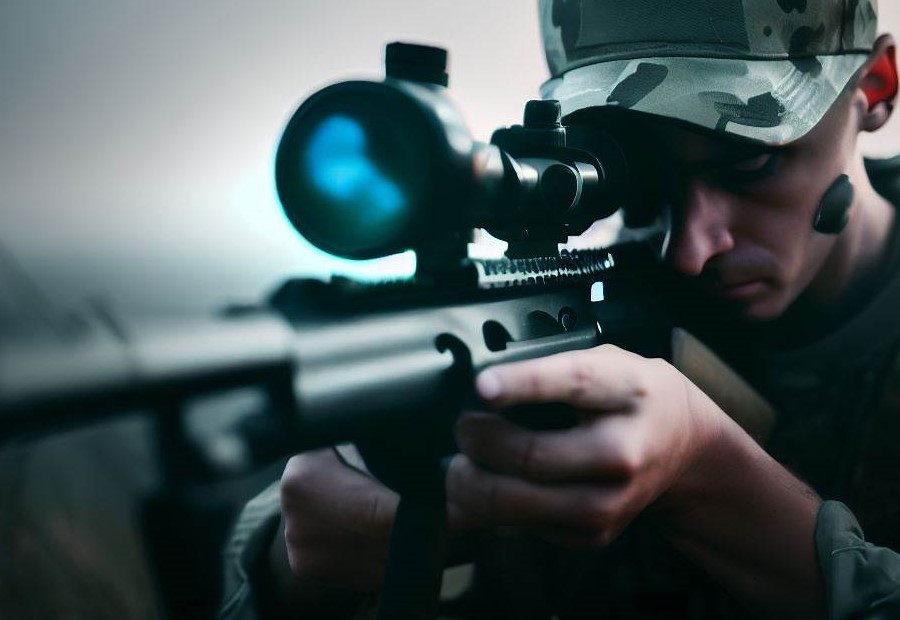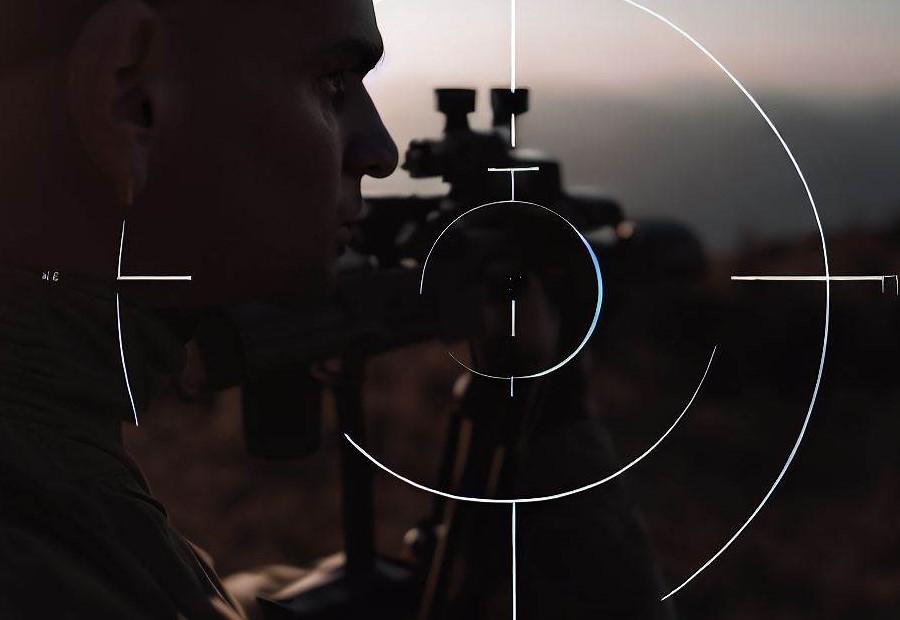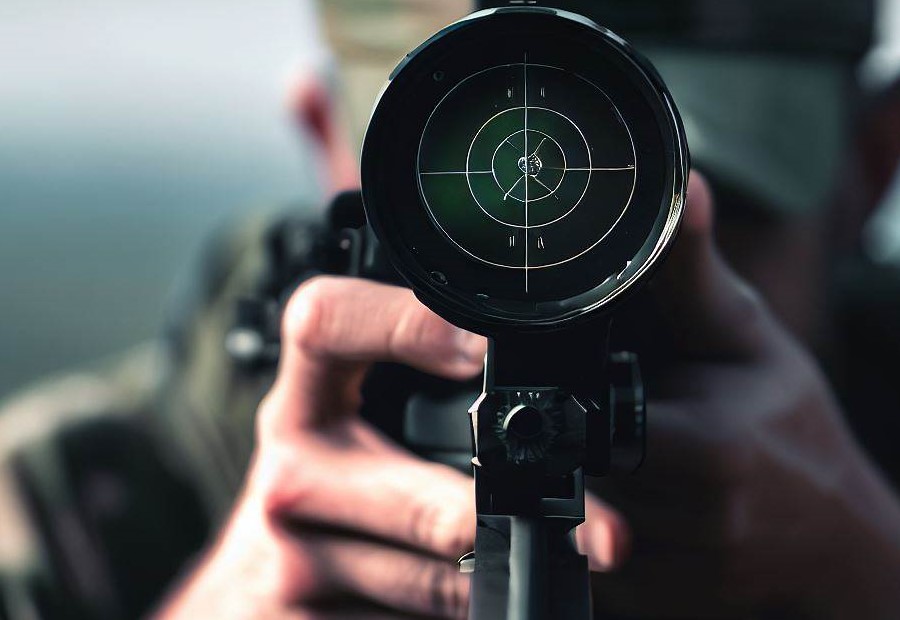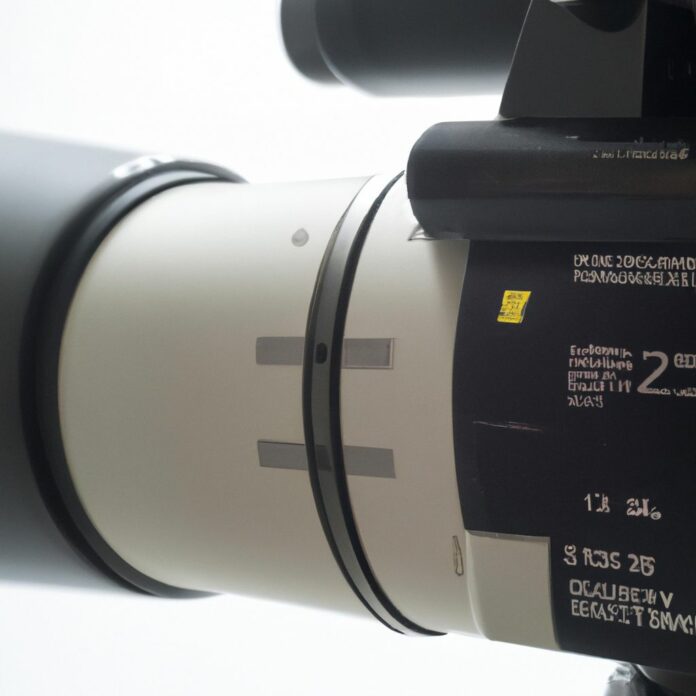Utilizing a range-finding reticle in a scope can greatly enhance your accuracy and precision when shooting at varying distances. Whether you are a hunter, shooter, or engaged in long-range shooting, understanding how to effectively use a range-finding reticle is essential. Here is a comprehensive guide to help you master this technique and make accurate shots.
A range-finding reticle, also known as a ballistic reticle, is a specialized type of reticle found in scopes that aids in estimating the distance to a target. It consists of hash marks, dots, or other markings that allow you to make precise adjustments for bullet drop and holdover.
By understanding the fundamentals of range-finding reticles and following these guidelines, you can effectively use this feature in your scope to improve your shooting accuracy and precision.
Understanding Range-Finding Reticles

Below is a table providing a breakdown of the different types of range-finding reticles commonly used in scopes:
| Type of Reticle | Purpose |
|---|---|
| BDC Reticle | Estimates bullet drop at various ranges |
| Mil-Dot Reticle | Measures distance to target in mils |
| Horus Reticle | Provides precise range estimation |
| Christmas Tree Reticle | Assists in elevation and windage adjustments |
| MOA Reticle | Calculates minute of angle for distance |
These range-finding reticles serve various purposes when using a scope. Understanding the range-finding reticles is important for shooters to make more accurate adjustments and calculations while using a scope.
The BDC reticle helps shooters estimate bullet drop at different distances, while the Mil-Dot reticle allows them to measure the distance to the target using mils. The Horus reticle provides precise range estimation, and the Christmas Tree reticle aids in making adjustments for elevation and windage. Lastly, the MOA reticle helps calculate the minute of angle for determining distance.
By understanding these different types of range-finding reticles, shooters can make more accurate adjustments and calculations while using a scope. It is important to consider the specific type of shooting and the desired level of precision when selecting the appropriate range-finding reticle for a scope.
What is a Range-Finding Reticle?
A range-finding reticle is a valuable tool for shooters, found in scopes, that helps estimate the distance to their target. It is designed to assist in making accurate long-range shots. The reticle is equipped with markings or stadia lines that enable the shooter to measure the size of the target and use that information to calculate the distance.
These markings are calibrated based on either the known size of the target or the average sizes of common objects. By aligning the target with the reticle and utilizing the appropriate holdover or holdunder, shooters can compensate for bullet drop at various distances.
Range-finding reticles function by utilizing angular measurements. When viewed through the scope, the size of the target is compared to the reticle markings. By using the known size of the target and corresponding measurement on the reticle, shooters can estimate the distance to the target. This estimation is especially vital for achieving accuracy while engaging targets at different distances.
How Does a Range-Finding Reticle Work?
A range-finding reticle works by utilizing a pattern of marks and dots on the scope’s crosshairs to help estimate the distance to the target.
When looking through the scope, the shooter can align the marks or dots on the reticle with specific points on the target to make an estimation.
The reticle is specially designed so that the spacing between the marks or dots corresponds to a known distance at a specific magnification setting of the scope.
For example, if the reticle is calibrated to work at a magnification setting of 10x, each mark on the reticle might represent 100 yards.
By comparing the size of the target in relation to the markings on the reticle, the shooter can estimate the target’s distance.
This estimation is crucial for making accurate adjustments for bullet drop and holdover.
It’s important to note that the effectiveness of a range-finding reticle depends on the shooter’s familiarity with the reticle, as well as environmental factors such as wind speed and direction.
Practice and experience are key to using a range-finding reticle effectively.
Fact: Range-finding reticles can help shooters make quick and accurate distance estimations, enhancing their shooting proficiency in various scenarios.
How to Use a Range-Finding Reticle in a Scope?

Looking to master the art of using a range-finding reticle in your scope? Look no further! In this section, we’ll uncover the step-by-step process to ensure accurate and precise shots. From determining the magnification setting to adjusting for windage, we’ll cover it all.
So, grab your scope and get ready to elevate your shooting skills to the next level!
Determine the Magnification Setting
To determine the magnification setting when using a range-finding reticle in a scope, follow these steps:
- Start by adjusting the scope’s zoom or magnification ring to its lowest setting.
- Point the scope towards a target or object in the distance.
- Slowly increase the magnification until the target appears clear and crisp.
- Take note of the magnification setting displayed on the scope.
This step is crucial as it ensures that you have the appropriate level of zoom to accurately estimate the distance and use the reticle effectively.
Estimate the Distance to the Target
To estimate the distance to the target while using a range-finding reticle, follow these steps:
- Adjust the magnification setting on the scope to achieve optimum clarity.
- Use the reticle’s features, such as Mil dots or hash marks, to measure the size of the target and estimate the distance.
- Refer to the reticle’s user manual or documentation to determine the specific measurement scale or subtension for more accurate estimation.
- Based on the known size of the target and the corresponding subtension, calculate the estimated distance using the provided formula.
- Adjust the estimation based on environmental factors, such as wind speed, humidity, and temperature, using the appropriate formulas or calculations.
It is important to note that estimating the distance to the target accurately is crucial for making precise adjustments and achieving accurate shots. The range-finding reticle provides a reliable method for estimating distance.
However, practice and familiarity with the reticle are key to mastering this skill. Regularly practicing with the reticle in various shooting conditions will enhance proficiency and improve accuracy. By considering environmental factors and making the necessary adjustments, shooters can optimize their shots and make informed decisions while using a range-finding reticle in a scope.
Align the Target Using the Reticle

- Make sure that your scope is securely attached to your firearm.
- Peek through the scope and locate the target.
- Utilize the elevation and windage knobs to center the reticle on the target.
- If necessary, make slight adjustments to fine-tune the alignment.
- Take advantage of the reticle’s crosshairs or other aiming points to align with specific features on the target, such as the bullseye.
- Maintain a steady position and hold the firearm consistently to ensure precise alignment.
- Take a moment to examine the target through the scope and double-check the alignment.
- Once you are confident that the reticle is accurately aligned with the target, you can proceed to the next steps of utilizing the range-finding reticle.
Use the Correct Holdover or Holdunder
This step is crucial for accurately adjusting your aim based on the distance to the target.
- Identify the distance: Determine the distance to the target using the reticle or other range-finding methods.
- Know your ballistic data: Understand the bullet’s trajectory and the distance at which it starts to drop significantly.
- Choose the right holdover/holdunder: Based on the distance and your ballistic data, use the reticle’s hash marks or subtensions to determine the appropriate holdover (aiming above the target) or holdunder (aiming below the target).
- Align the reticle: Place the appropriate hash mark or subtension onto the target, adjusting your aim vertically based on the calculated holdover or holdunder.
- Take the shot: Once the reticle is aligned, you can confidently squeeze the trigger and make the shot.
Adjust for Windage
To adjust for windage when using a range-finding reticle in a scope, follow these steps:
- Determine the direction and speed of the wind. Observe the movement of trees, leaves, or grass to assess the wind’s direction and estimate its speed. Understanding wind conditions is crucial for accurate shooting.
- Use the markings on your reticle to compensate for wind drift. Windage markings on the reticle can help you make adjustments for the wind’s effect on your shot. These markings indicate how much you need to adjust your aim to compensate for windage.
- Estimate the value of the windage adjustment. Based on the wind’s speed and your target distance, use the windage markings to determine the appropriate adjustment needed. Each reticle will have specific instructions for how much each marking corresponds to in terms of windage.
- Adjust your aim accordingly. Once you have estimated the windage adjustment value, move the reticle horizontally in the direction opposite to the wind’s movement. This adjustment will compensate for the wind’s effect on your bullet’s trajectory.
- Adjust for Windage. After making the necessary windage adjustments, align your reticle with the target using the adjusted aim point. Take your shot while keeping the windage adjustment in mind.
For better accuracy, consider practicing shooting in different wind conditions and familiarizing yourself with your specific reticle’s windage markings. It is important to adjust for windage to ensure your shots hit the intended target.
Tips and Techniques for Using a Range-Finding Reticle

Looking to master the art of using a range-finding reticle in your scope? Get ready to uncover valuable tips and techniques that will take your shooting skills to new heights.
We’ll dive into the subtleties of understanding reticle subtensions, offer advice on how to practice and familiarize yourself with the reticle, and even explore the influence of environmental factors. Prepare to enhance your precision and accuracy on the field like never before!
Understanding Reticle Subtensions
When using a range-finding reticle in a scope, it is crucial to have a thorough understanding of reticle subtensions. These subtensions encompass specific measurements and markings on the reticle that greatly assist with range estimation and holdovers.
| Reticle Subtensions | Description |
| Mil-Dots | Mil-dots are a common type of reticle subtension utilized for estimating the distance to a target. Each mil-dot accurately represents a specific angular measurement, thereby allowing for precise range estimation. |
| MOA Marks | MOA (Minute of Angle) marks serve as another type of reticle subtension that greatly aids in range estimation. Each MOA mark represents an exact angular measurement, ensuring accurate calculation of target distance. |
| Hashmarks | Hashmarks are effectively used to indicate holdover or holdunder points for different distances. By aligning the target with the appropriate hashmark, shooters can effectively compensate for bullet drop and accurately hit their intended target. |
| Range Bars | The reticle features range bars, which serve as markings representing specific distances. Shooters can quickly estimate the target’s distance by aligning it with the corresponding range bar, eliminating the need for calculations. |
Understanding these reticle subtensions is absolutely essential for effectively utilizing a range-finding reticle. They provide crucial information for precise range estimation, holdovers, and compensating for bullet drop. To enhance your shooting accuracy and precision when using a range-finding reticle in a scope, it is highly recommended to familiarize yourself with the subtensions on your reticle and practice using them.
Additionally, it is important to consider environmental factors such as windage and make necessary adjustments for optimal shooting performance.
Practice and Familiarize with the Reticle
To effectively use a range-finding reticle in a scope, it is important to practice and familiarize yourself with the reticle. Here are some steps to follow:
- Understand the different markings and measurements on the reticle. Each reticle may have variations, so take the time to study and comprehend the specific reticle you are using.
- Practice using the reticle at various distances. Set up targets at different ranges and experiment with using the reticle to estimate the distance and make accurate shots.
- Pay attention to the subtensions on the reticle. These are the lines or dots that help you measure the distance to the target. Understand how the subtensions correspond to specific distances.
- Adjust the magnification on your scope to see the reticle more clearly. Finding the right magnification setting can improve your accuracy when using the reticle.
- Regularly practice using the reticle in varying shooting scenarios. This will help you become more comfortable and proficient in using it in real-life situations.
By practicing and familiarizing yourself with the reticle, you will enhance your ability to accurately estimate distance and make precise shots. Remember to always consider environmental factors such as wind and light conditions, which can affect your shooting. With time and practice, you will become more confident in using the range-finding reticle to improve your shooting skills.
Consider Environmental Factors
When using a range-finding reticle in a scope, we must prioritize observing and understanding environmental factors before taking a shot. It is important to consider environmental factors that can affect your shot and play a significant role in the accuracy and precision of your shooting.
- Weather conditions: Take into account factors such as wind speed and direction, humidity, and temperature. Wind, especially, can have a significant impact on bullet trajectory, so make sure to adjust your aim accordingly.
- Lighting conditions: Consider the lighting conditions at the time of your shot. Changes in brightness, shadows, and glare can affect your ability to see the reticle clearly and make accurate judgments.
- Terrain: Evaluate the characteristics of the terrain, including elevation, slope, and vegetation. These factors can influence bullet drop and the trajectory, requiring you to adapt your holdover or holdunder accordingly.
Pro-tip: We must consider environmental factors before taking a shot. By carefully considering factors such as weather conditions, lighting conditions, and terrain characteristics, we can make necessary adjustments to improve our shooting accuracy and increase our chances of hitting the target successfully.
Common Mistakes to Avoid When Using a Range-Finding Reticle

When it comes to using a range-finding reticle in a scope, there are some common mistakes that you definitely want to steer clear of. From neglecting to account for bullet drop to inaccurately estimating distance and ignoring windage, these slip-ups can seriously hinder your shooting accuracy.
In this section, we’ll go over these blunders in detail, shedding light on the importance of avoiding them and providing you with the knowledge you need to make the most out of your range-finding reticle. Get ready to take your shooting skills to the next level!
Not Accounting for Bullet Drop
Not accounting for bullet drop can have a significant impact on the accuracy of shots when using a range-finding reticle in a scope. Bullet drop refers to the decrease in the trajectory of a bullet as it travels downrange. Failing to account for this drop can lead to shots falling short of the target.
To ensure accuracy, it is important to understand the ballistics of the ammunition being used. Different bullets have different drop rates based on factors such as velocity, bullet weight, and aerodynamics. By knowing the specific ballistics of your ammunition, you can make the necessary adjustments to compensate for bullet drop.
One common mistake is assuming that the reticle will automatically account for bullet drop. While range-finding reticles can be useful in estimating distance, they do not factor in bullet drop on their own. It is the shooter’s responsibility to make the necessary adjustments to compensate for this drop.
To account for bullet drop, shooters can refer to ballistic tables or use ballistic calculators to determine the amount of holdover or elevation adjustment needed for a specific distance. It is important to practice and familiarize oneself with these calculations and adjustments to ensure accurate shots.
Incorrectly Estimating Distance
Underestimating the distance to your target, or incorrectly estimating distance, can significantly impact the accuracy of using a range-finding reticle in a scope. To avoid this common mistake, follow these steps:
- Determine the Magnification Setting – Adjust the scope’s magnification to a level that allows you to clearly see the target and its surroundings.
- Estimate the Distance to the Target – Use visual cues such as the size of the target, nearby objects, or familiar landmarks to estimate the distance accurately. Avoid relying solely on your intuition or incorrectly estimating distance.
- Align the Target Using the Reticle – Aim the reticle at the target while keeping in mind the estimated distance. Ensure that the reticle is centered on the target for alignment.
- Use the Correct Holdover or Holdunder – Depending on the estimated distance, refer to the reticle’s markings to determine the appropriate holdover or holdunder to compensate for bullet drop.
- Adjust for Windage – Assess the wind direction and speed, and make the necessary adjustments to compensate for wind drift. Utilize the windage adjustment knobs on the scope if available.
By following these steps and accurately estimating the distance to your target, or not incorrectly estimating distance, you can increase the chances of hitting your mark when using a range-finding reticle in a scope. Avoiding the mistake of incorrectly estimating distance is crucial for precision and accuracy in long-range shooting.
Ignoring Windage
Ignoring windage is a mistake that should be avoided at all costs when using a range-finding reticle in a scope. The term windage refers to the impact of wind on the trajectory of a bullet, causing it to veer off course. Neglecting to consider windage can lead to missed shots or inaccurate hits.
To prevent the oversight of windage, it is crucial to assess the direction and speed of the wind. Paying attention to environmental cues such as the movement of trees, flags, or grass can offer insights into the strength and direction of the wind. Additionally, utilizing tools like wind meters or observing wind flags on the shooting range can provide quantitative data for factoring into calculations.
After determining the windage, adjustments should be made using the reticle. Most range-finding reticles include windage marks or dots that can be utilized to compensate for the wind’s impact on the bullet’s path. By aligning the reticle with the windage adjustment, the shooter can make the necessary corrections to ensure accuracy.
Ignoring windage can lead to missed shots or unintentionally hitting targets. To highlight the significance of accounting for windage, let’s consider the real-life story of a skilled shooter who consistently failed to hit his targets during a competition. Frustrated, he later realized that he had been disregarding windage in his calculations. Once he began factoring in windage, his accuracy improved significantly, ultimately leading him to victory in the competition.
Frequently Asked Questions
How does a rangefinder reticle in a scope help in distance estimation?
A rangefinder reticle in a scope helps in distance estimation by providing clear guidelines through vertical and horizontal lines. These lines can be used to measure the size or height of the target, which is then used in range estimation formulas.
What are the different methods for range estimation using a rangefinder reticle?
There are several methods for range estimation using a rangefinder reticle. One method is using the range formula, which involves knowing the scope’s magnification and the size or height of the target. Another method is to use Minute of Angle (MOA) or MIL (milliradian) calculations based on the target’s size or height.
What are the important things to consider when using a rangefinder reticle?
When using a rangefinder reticle, it is important to have a clear sight picture, larger eye relief, and a wide field of view. Understanding optics terminology, having basic math skills, and practicing with the reticle are also important for accurate readings and reliable estimations.
Can a rangefinder scope with a reticle help extend hunting hours?
Yes, a rangefinder scope with a reticle can help extend hunting hours. Some scopes have night vision capability, allowing hunters to see further and better in low-light conditions. This can greatly enhance hunting opportunities during dawn and dusk.
What are the advantages and disadvantages of using a rangefinder scope with a reticle?
The advantages of using a rangefinder scope with a reticle include easy usability, clear distance comprehension, adaptability with multiple measurement modes, and the ability to provide visual information in low-light conditions. However, the disadvantages include the need for calculations, sensitivity to miscalibration or angles, and the potential heaviness and bulkiness of high-spec models.
What are some recommended rangefinder scopes with reticles for accurate long-range shooting?
Some recommended rangefinder scopes with reticles for accurate long-range shooting include the Mileseey LK01 Auxiliary Ballistic Smart Laser Rangefinder. This model offers compatibility with various hunting solutions, a range of up to 1200 yards, improved lens set, and smart controls. It is designed to improve game accuracy and extend shooting range.

